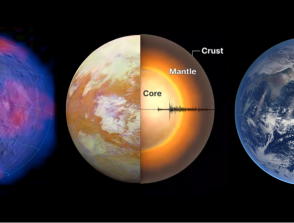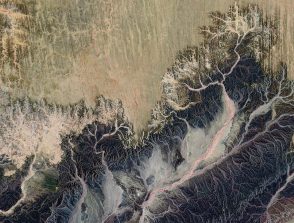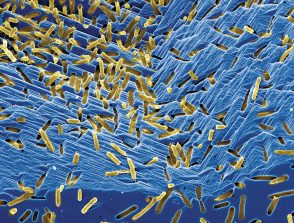CNES Research project: Dragonfly landing site characterization on Titan: geological and climatic history on the region of the Selk crater

Artist's view of the Dragonfly mission on the surface of Titan and the surrounding dunes.
Start: 01/01/2020
National partnership
Coordinators : Sébastien Rodriguez
Host institutions :
IPGP
Partner institutions :
LPGN, LATMOS, LMD, MSC, GSMA, LESIA
Related teams :
Planetology and Space Sciences
Related themes :
Earth System Science, Origins
Our project aims at implementing an original methodology coupling information extraction on the nature of Titan’s surface (analysis of Cassini-Huygens imaging and spectroscopy data) and understanding of landscape formation and sediment transport processes by wind and river erosion (numerical simulations, laboratory experiments and theoretical developments). We therefore propose, for this project, to test and validate this methodology on the Selk crater region and on the surrounding dunes and rivers, in preparation of the future ground and flight activities of the Dragonfly mission. This work is also intended to support the future scientific activities of the French Co-Is on the DraMS and DraGMet instruments (in particular for what concerns the surface composition and the speed and direction of the near surface winds).
We propose to quantitatively study the surface composition, morphogenesis and dynamics of dunes and river networks on Titan, with the objective of constraining the formation mechanisms of these structures and characterizing the exotic chemical, climatic and geological environment in which they form. Our approach combines analysis of observations of Titan’s surface made by the Cassini orbiter (NASA) and the Huygens lander (ESA), numerical and experimental modeling of landscape formation, and global and regional climate modeling. By focusing on the study of its landing site and the surrounding region, this multidisciplinary project is part of the long-term operational and scientific preparation of NASA’s New Frontiers mission Dragonfly, which will land a drone on Titan in 2034. Dragonfly will be the next mission to explore Titan since the end of the Cassini mission in September 2017 and will have as its major scientific objectives the in situ study of the complexity of Titan’s organic chemistry, geology, and climate activity.
It is crucial to proceed now to a complete analysis of the Dragonfly landing site, while the expertise of the Cassini mission is still active. This long-term work will benefit from strong and long-standing collaborations both nationally (co-proponents of the application, including a Co-I of the Dragonfly mission) and internationally (PI and Co-Is of the Dragonfly mission: Alexander Hayes, Jason Barnes, Jason Soderblom, Shannon MacKenzie, Ralph Lorenz, Elizabeth Turtle).
The French scientific community and CNES are already very active in contributing to the Dragonfly mission. CNES support to this research project, in addition to its support to the three French Co-Is for instrumental development, allows to consolidate national collaborations and to position France in the best conditions to contribute to the Dragonfly mission and to the further exploration of Titan. Indeed, the French community is in second place just behind the United States on the study of Titan (all themes combined).






